Modeling and Static Analysis of Primary Consequent-Pole Tubular Transverse-Flux Flux-Reversal Linear Machine
Abstract
:1. Introduction
2. Structure and Principle
2.1. Structure of the Primary Consequent-Pole TTFFRLM
2.2. Working Principle and Topology Structure of the Primary PM Consequent-Pole TTFFRLM
3. Mathematical Model Analysis based on Magnetic Circuit Method
3.1. Equivalent Magnetic Circuit Model of the Unit Machine and No-Load Back-EMF
3.2. Electromagnetic Thrust Force
4. Equivalent Two-Dimensional Finite Element Method
4.1. Magnetic Field Analysis of the Unit Machine
4.2. Harmonic Analysis of the No-Load Back-EMF
4.3. Detent Force and Electromagnetic Thrust Force
5. Test Results and Analysis of the Prototype
6. Conclusions
- (1)
- The primary is easily manufactured, and the secondary is only composed of magnetically conductive iron cores, which can reduce the application cost of the long stroke drive systems.
- (2)
- The dual N poles type of the PMs distributed in the circumferential direction can reduce circumferential leakage magnetic flux and improve the utilization ratio of PM.
- (3)
- When compared with conventional TTFFRLM, the proposed machine can save half the amount of PMs. Meanwhile, the electromagnetic thrust force ripple is much smaller.
Acknowledgments
Author Contributions
Conflicts of Interest
References
- Kou, B.Q.; Wu, H.X.; Li, L.Y.; Zhang, L.L.; Zhao, Z.; Cao, H.C. The thrust characteristics investigation of double-side plate permanent magnet linear synchronous motor for EML. IEEE Trans. Magn. 2009, 45, 501–505. [Google Scholar]
- Hasanien, H.M.; Abd-Rabou, A.S.; Sakr, S.M. Design optimization of transverse flux linear motor for weight reduction and performance improvement using response surface methodology and genetic algorithms. IEEE Trans. Energy Convers. 2010, 25, 598–605. [Google Scholar] [CrossRef]
- Li, L.Y.; Pan, D.H.; Huang, X.Z. Analysis and optimization of ironless permanent-magnet linear motor for improving thrust. IEEE Trans. Plasma Sci. 2013, 41, 1188–1192. [Google Scholar] [CrossRef]
- Chen, M.Y.; Lu, J.S. High-precision motion control for a linear permanent magnet Iron core synchronous motor drive in position platform. IEEE Trans. Ind. Inform. 2014, 10, 99–108. [Google Scholar] [CrossRef]
- Chung, S.U.; Kim, J.M. Double-sided iron-core PMLSM mover teeth arrangement design for reduction of detent force and speed ripple. IEEE Trans. Ind. Electron. 2016, 63, 3000–3008. [Google Scholar] [CrossRef]
- Song, J.C.; Dong, F.; Zhao, J.W.; Lu, S.L.; Li, L.; Pan, Z.B. A new design optimization method for permanent magnet synchronous linear motors. Energies 2016, 9, 992. [Google Scholar] [CrossRef]
- Cao, R.W.; Cheng, M.; Mi, C.C.; Hua, W. Influence of leading design parameters on the force performance of a complementary and modular linear flux-switching permanent-magnet motor. IEEE Trans. Ind. Electron. 2014, 61, 2165–2175. [Google Scholar] [CrossRef]
- Chung, S.U.; Lee, H.J.; Hwang, S.M. A novel design of linear synchronous motor using FRM topology. IEEE Trans. Magn. 2008, 44, 1514–1517. [Google Scholar] [CrossRef]
- Zhu, Z.Q.; Chen, X.; Chen, J.T.; Howe, D.; Dai, J.S. Novel linear flux switching permanent magnet machines. In Proceedings of the 2008 11th International Conference on Electrical Machines and Systems (ICEMS), Wuhan, China, 17–20 October 2008; pp. 2948–2953. [Google Scholar]
- Lu, Q.F.; Li, Y.X.; Ye, Y.Y.; Fang, Y.T. A novel transverse-flux switched-flux PM linear motor. In Proceedings of the 2013 16th International Conference on Electrical Machines and Systems (ICEMS), Busan, Korea, 26–29 October 2013; pp. 1907–1912. [Google Scholar]
- Urban, C.; Gunther, R.; Nagel, T.; Richter, R.; Witt, R. Development of a bendable permanent-magnet tubular linear motor. IEEE Trans. Magn. 2012, 48, 2367–2373. [Google Scholar] [CrossRef]
- Bianchi, N.; Bolognani, S.; Corte, D.D.; Tonel, F. Tubular linear permanent magnet motors: An overall comparison. IEEE Trans. Ind. Appl. 2003, 39, 466–475. [Google Scholar] [CrossRef]
- Wang, J.B.; Wang, W.Y.; Atallah, K.; Howe, D. Design considerations for tubular flux-switching PM machines. IEEE Trans. Magn. 2008, 44, 4026–4032. [Google Scholar] [CrossRef]
- Yan, L.; Li, W.; J, Z.X.; Chen, C.Y.; Chen, I.M. Design and modeling of three-phase tubular linear flux-switching permanent magnet motor. In Proceedings of the 2014 IEEE Chinese Guidance, Navigation and Control Conference, Yantai, China, 8–10 August 2014; pp. 2675–2680. [Google Scholar]
- Du, Y.; Chau, K.T.; Cheng, M.; Fan, Y.; Wang, Y.B.; Hua, W.; Wang, Z. Design and analysis of linear stator permanent magnet vernier machines. IEEE Trans. Magn. 2011, 47, 4219–4222. [Google Scholar] [CrossRef] [Green Version]
- Du, Y.; Chau, K.T.; Cheng, M.; Fan, Y.; Zhao, W.; Li, F. A linear stator permanent magnet vernier HTS machine for wave energy conversion. IEEE Trans. Appl. Supercond. 2012, 22, 5202505. [Google Scholar] [CrossRef]
- Ji, J.H.; Zhao, J.X.; Zhao, W.X.; Fang, Z.Y.; Liu, G.H.; Du, Y. New high force density tubular permanent-magnet motor. IEEE Trans. Appl. Supercond. 2014, 24, 1–5. [Google Scholar] [CrossRef]
- Boldea, I.; Nasar, S.A.; Penswick, B.; Ross, B.; Olan, R. New linear reciprocating machine with stationary permanent magnets. In Proceedings of the 1996 Industry Applications Conference, 31th IAS Annual Meeting, San Diego, CA, USA, 6–10 October 1996; pp. 825–829. [Google Scholar]
- Boldea, I.; Wang, C.X.; Yang, B.; Nasar, S.A. Analysis and design of flux-reversal linear permanent magnet oscillating machine. In Proceedings of the 1998 Industry Applications Conference, 33th IAS Annual Meeting, St. Louis, MO, USA, 12–15 October 1998; pp. 136–143. [Google Scholar]
- Kou, B.Q.; Luo, J.; Yang, X.B.; Zhang, L. Modeling and analysis of a novel transverse-flux flux-reversal linear motor for long-stroke application. IEEE Trans. Ind. Electron. 2016, 63, 6238–6248. [Google Scholar] [CrossRef]
- Wang, Q.; Zou, J.M.; Zou, J.B.; Zhao, M. Analysis and computer-aided simulation of cogging force characteristic of a linear electromagnetic launcher with tubular transverse flux machine. IEEE Trans. Plasma Sci. 2011, 39, 157–161. [Google Scholar] [CrossRef]
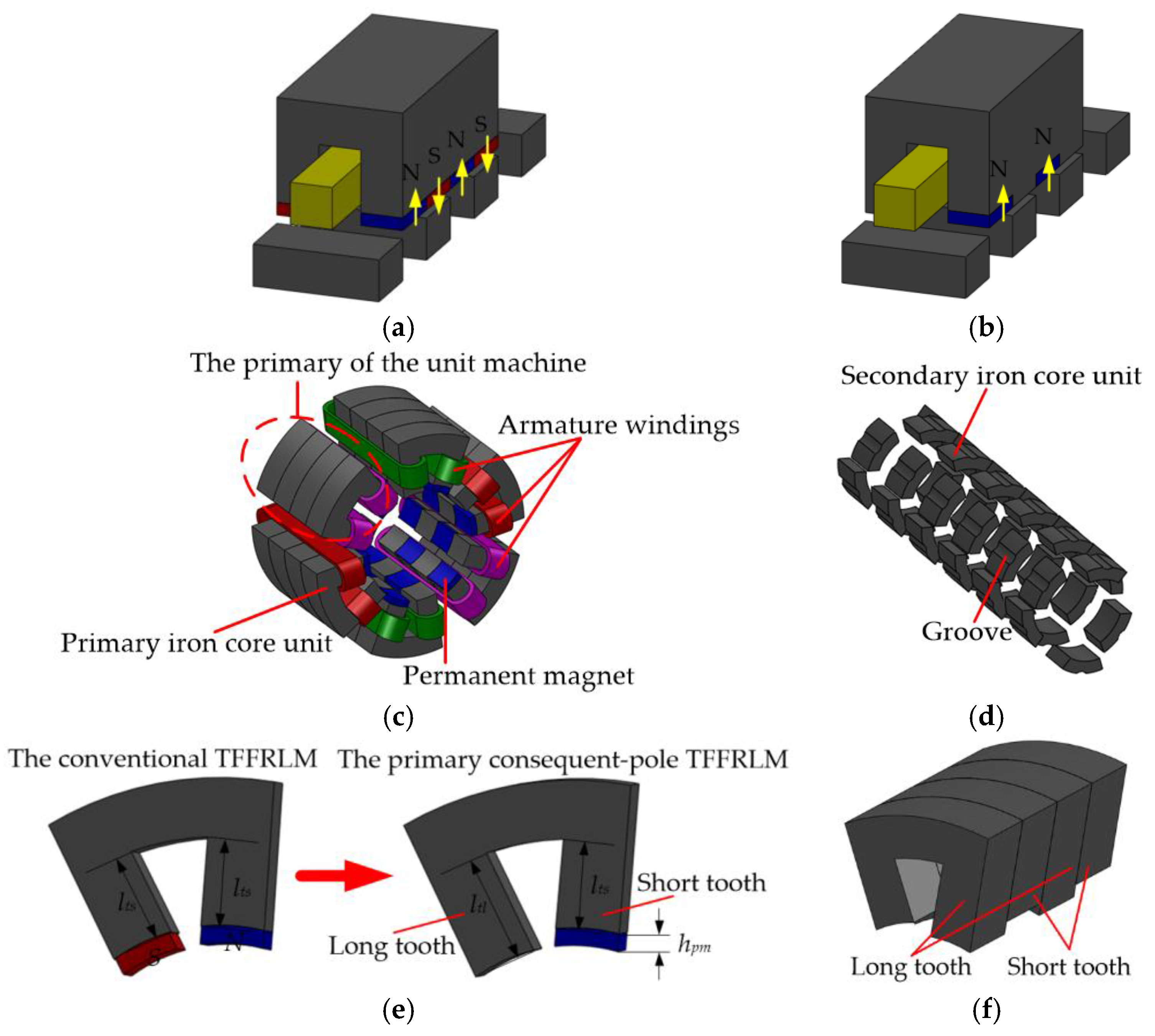
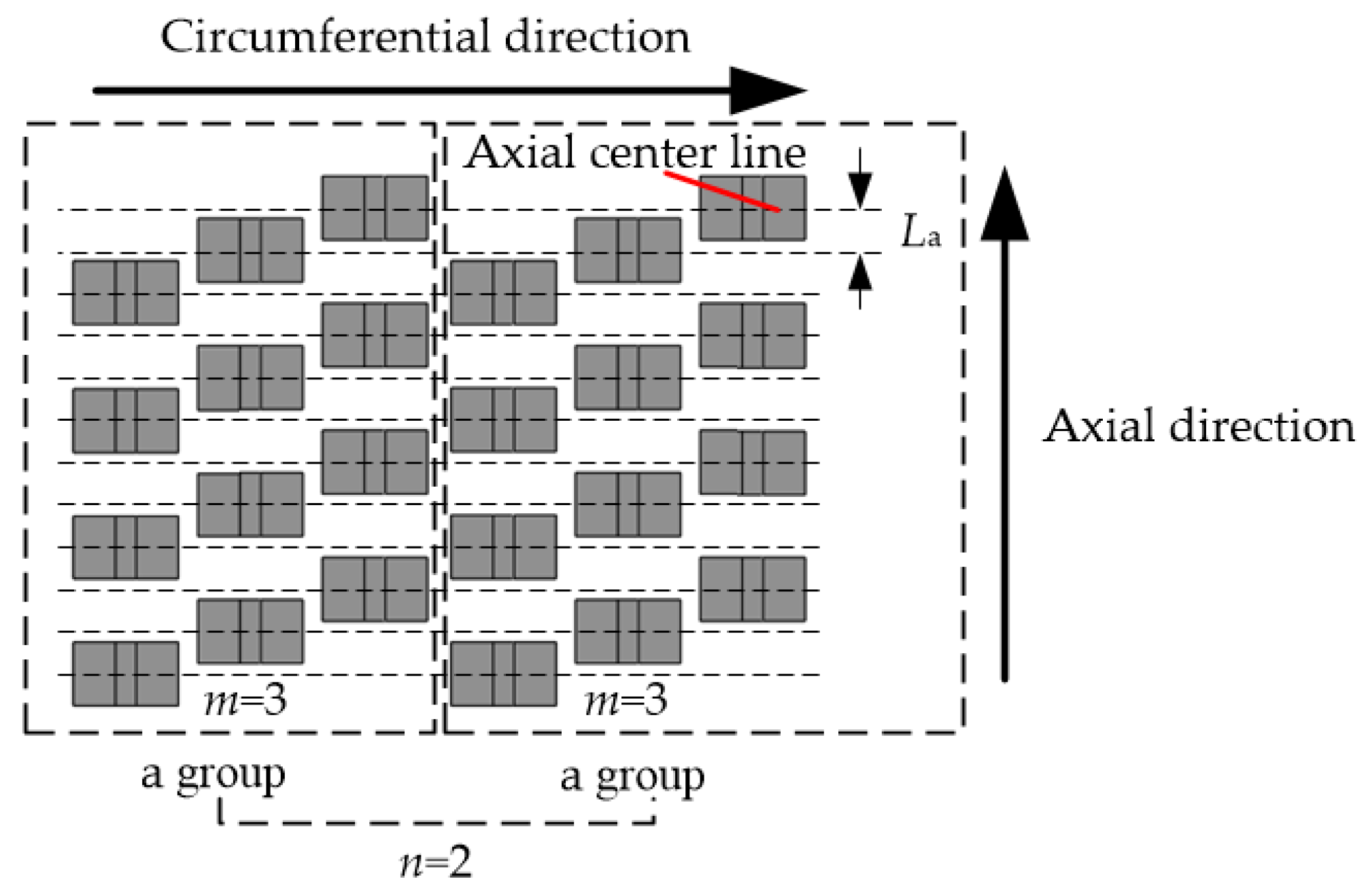
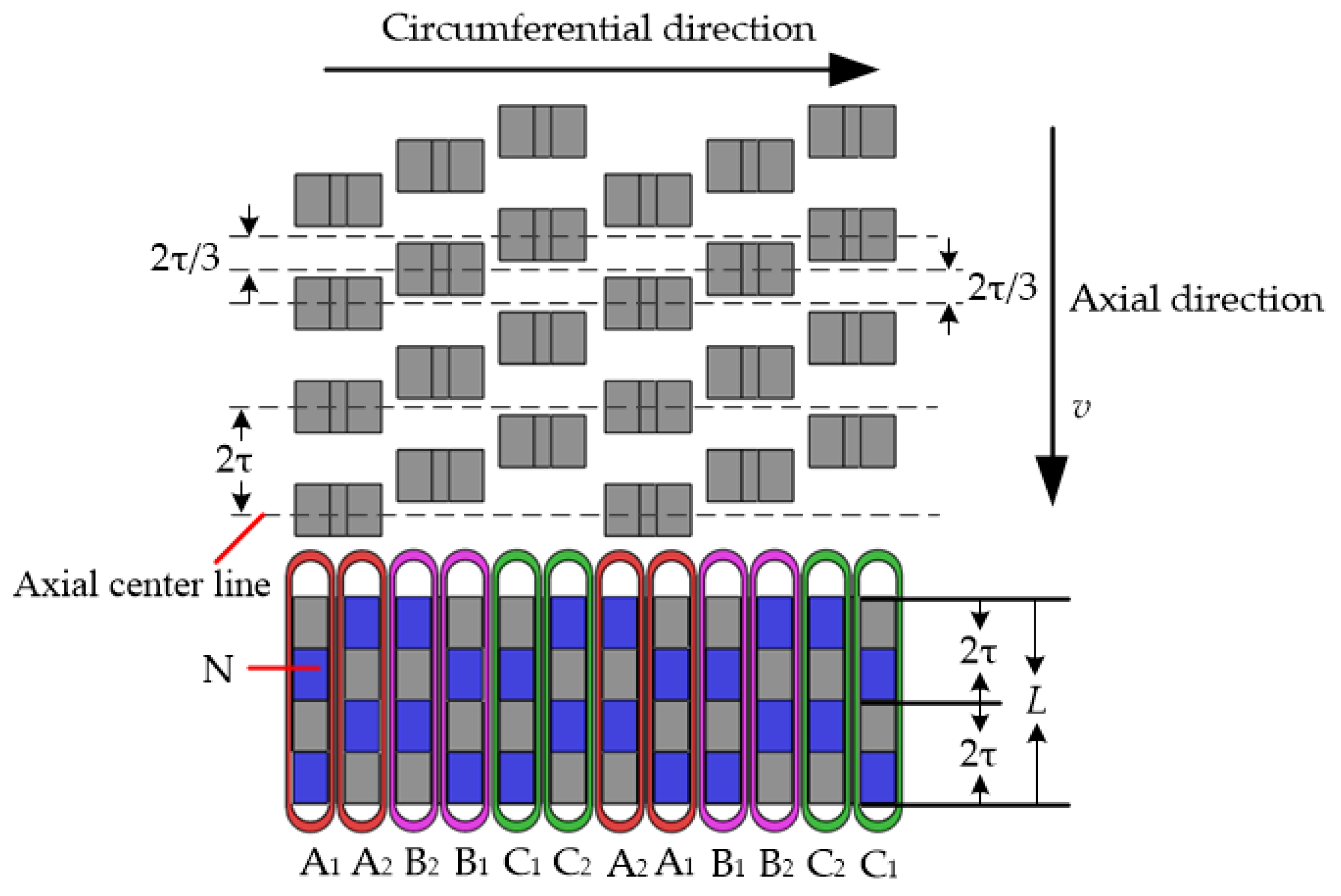
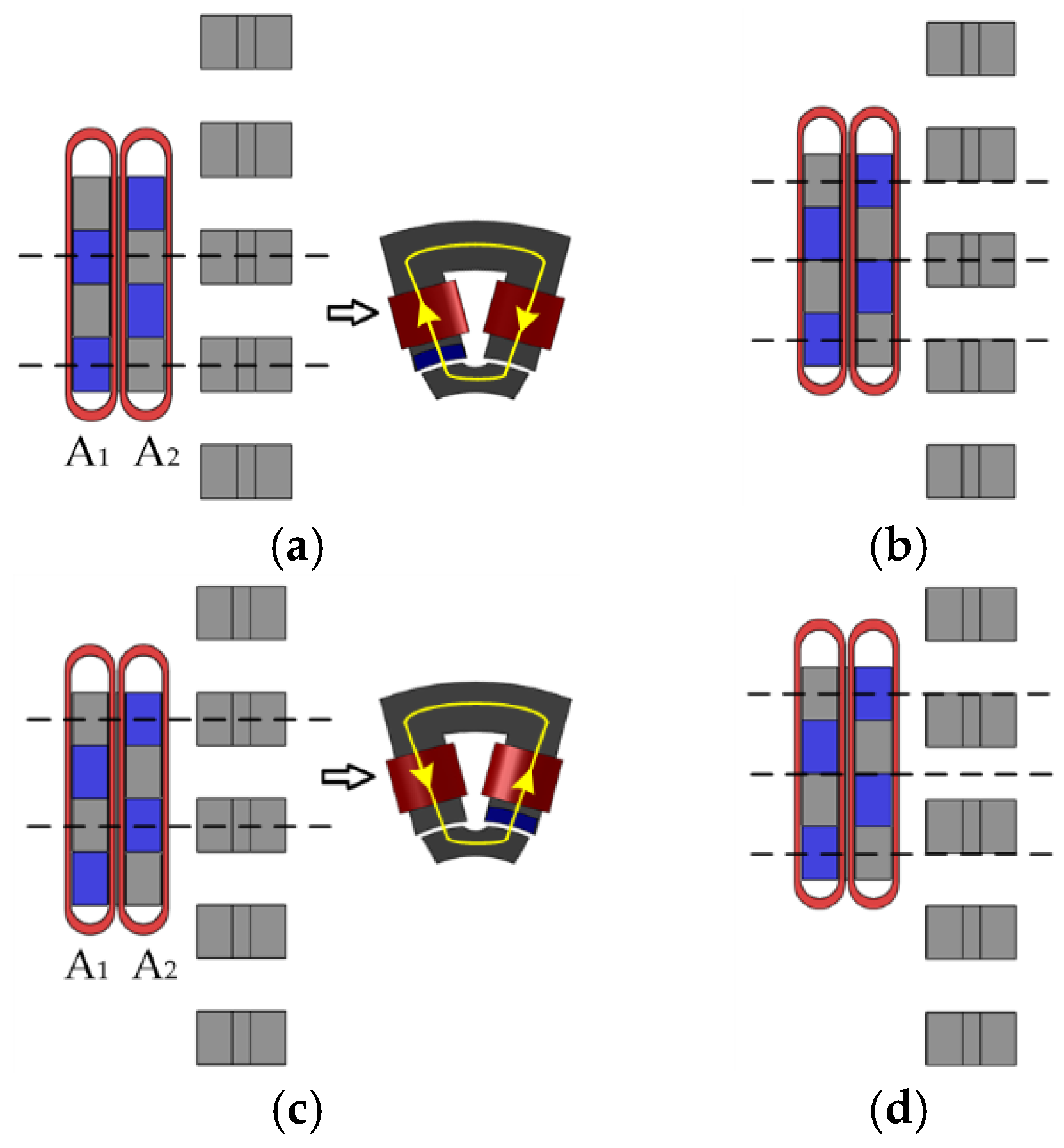
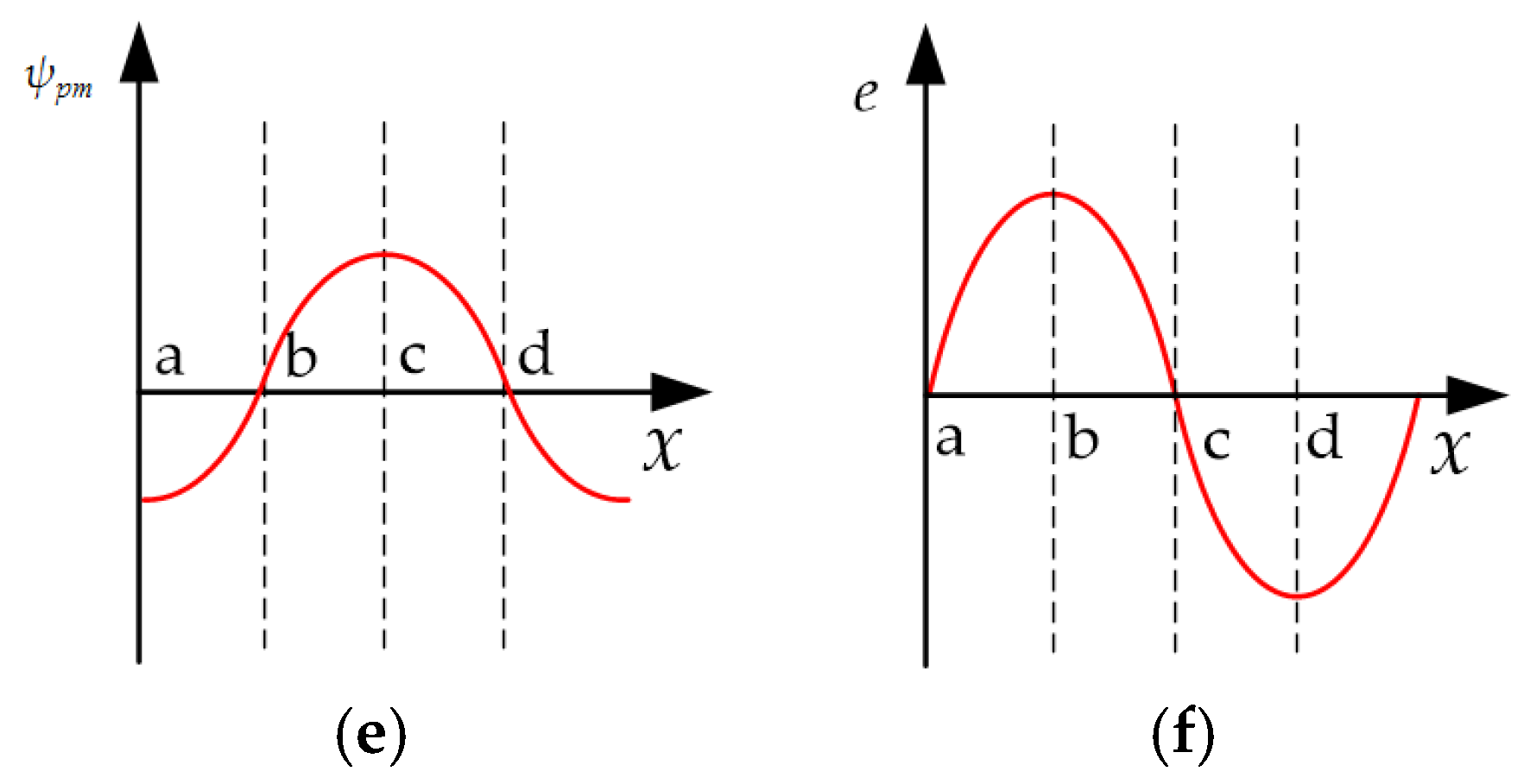
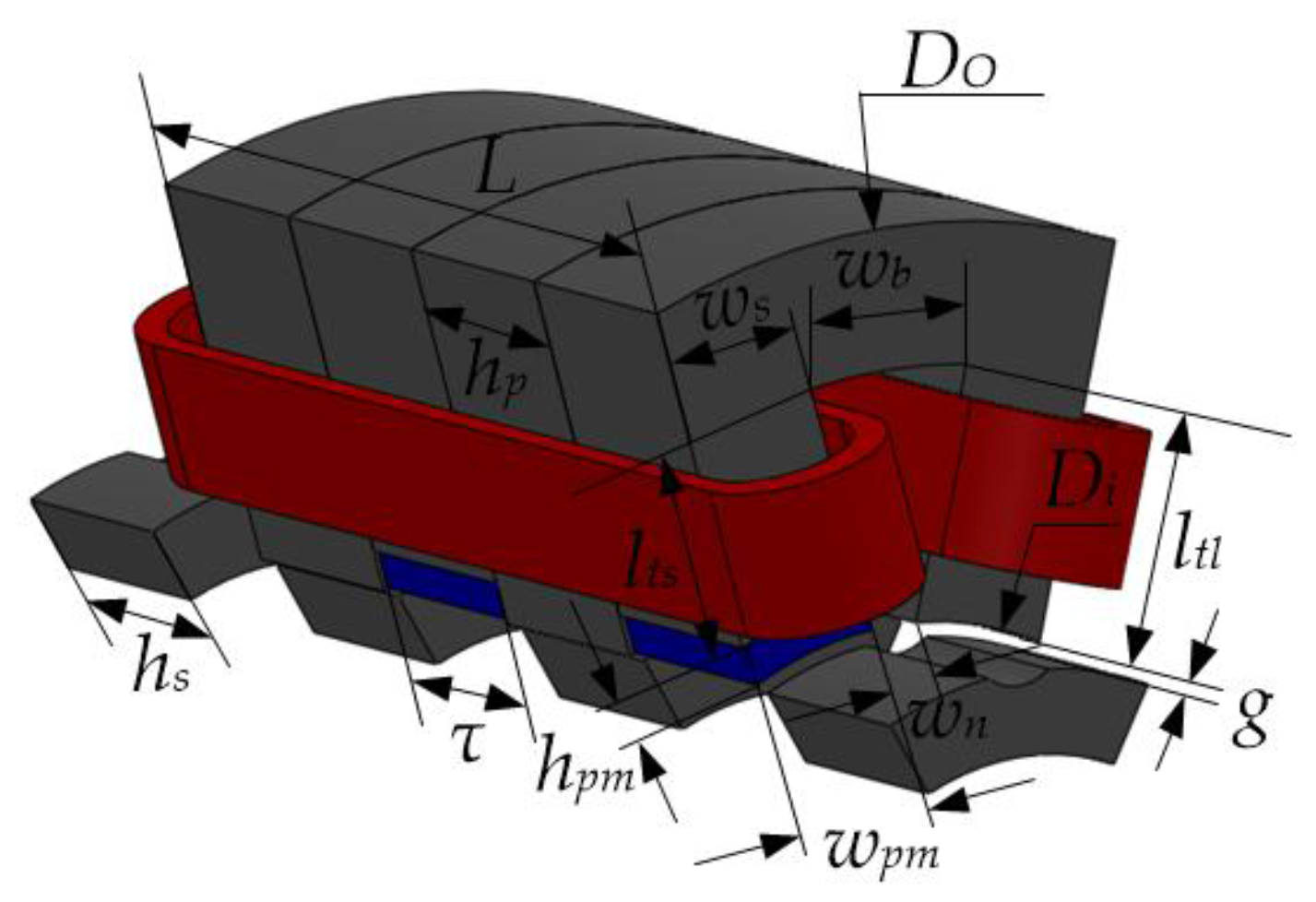


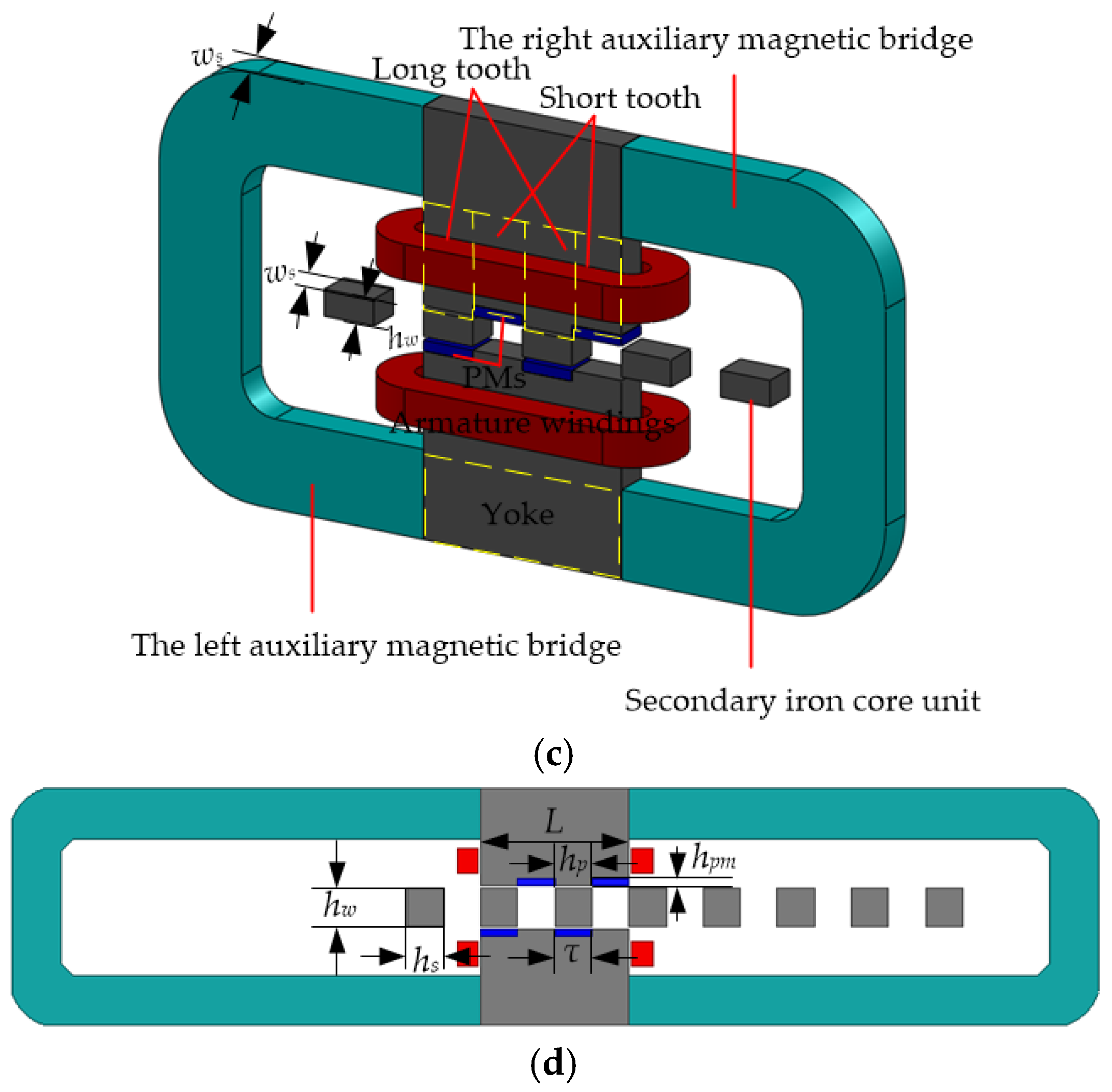
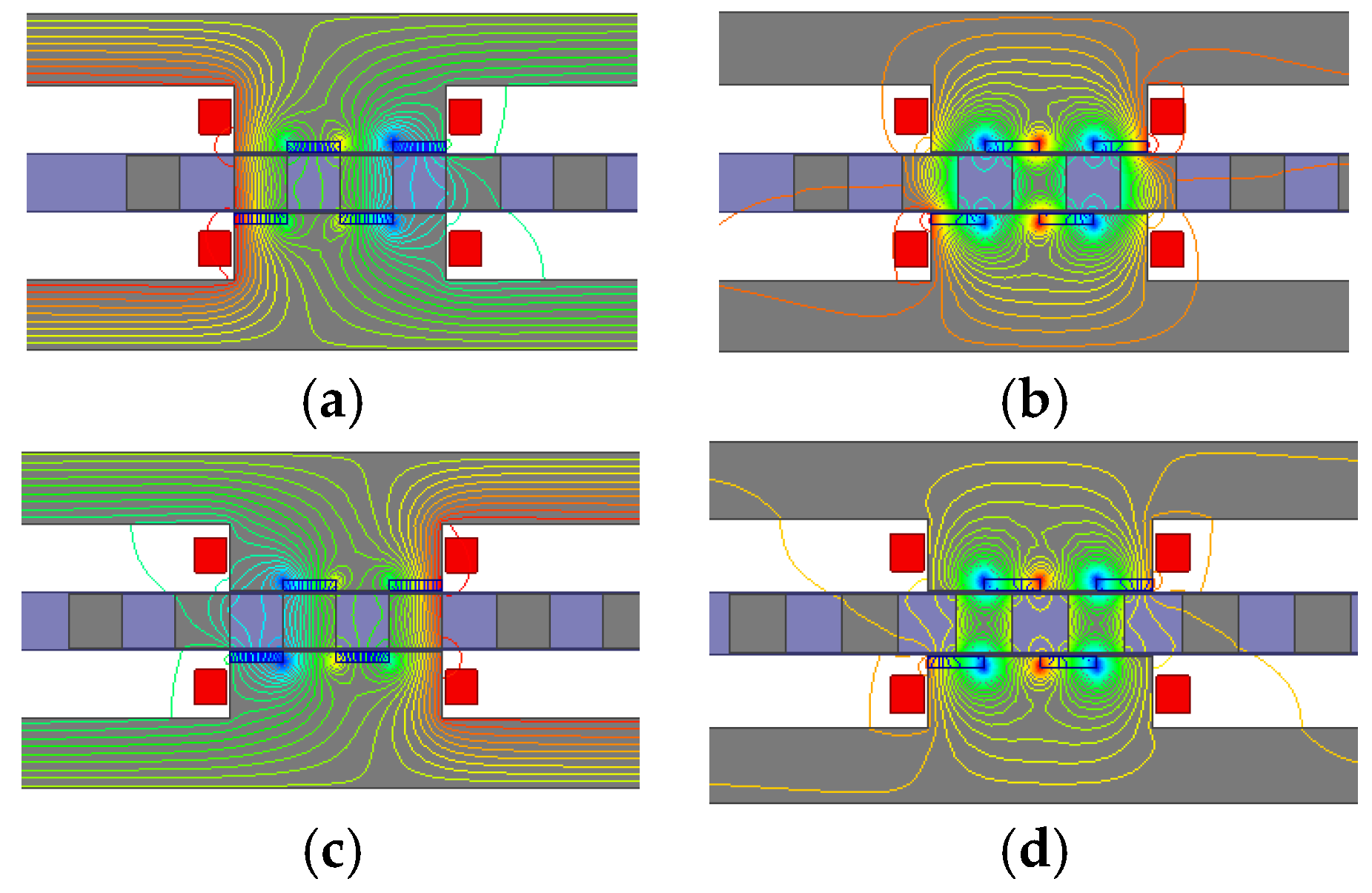

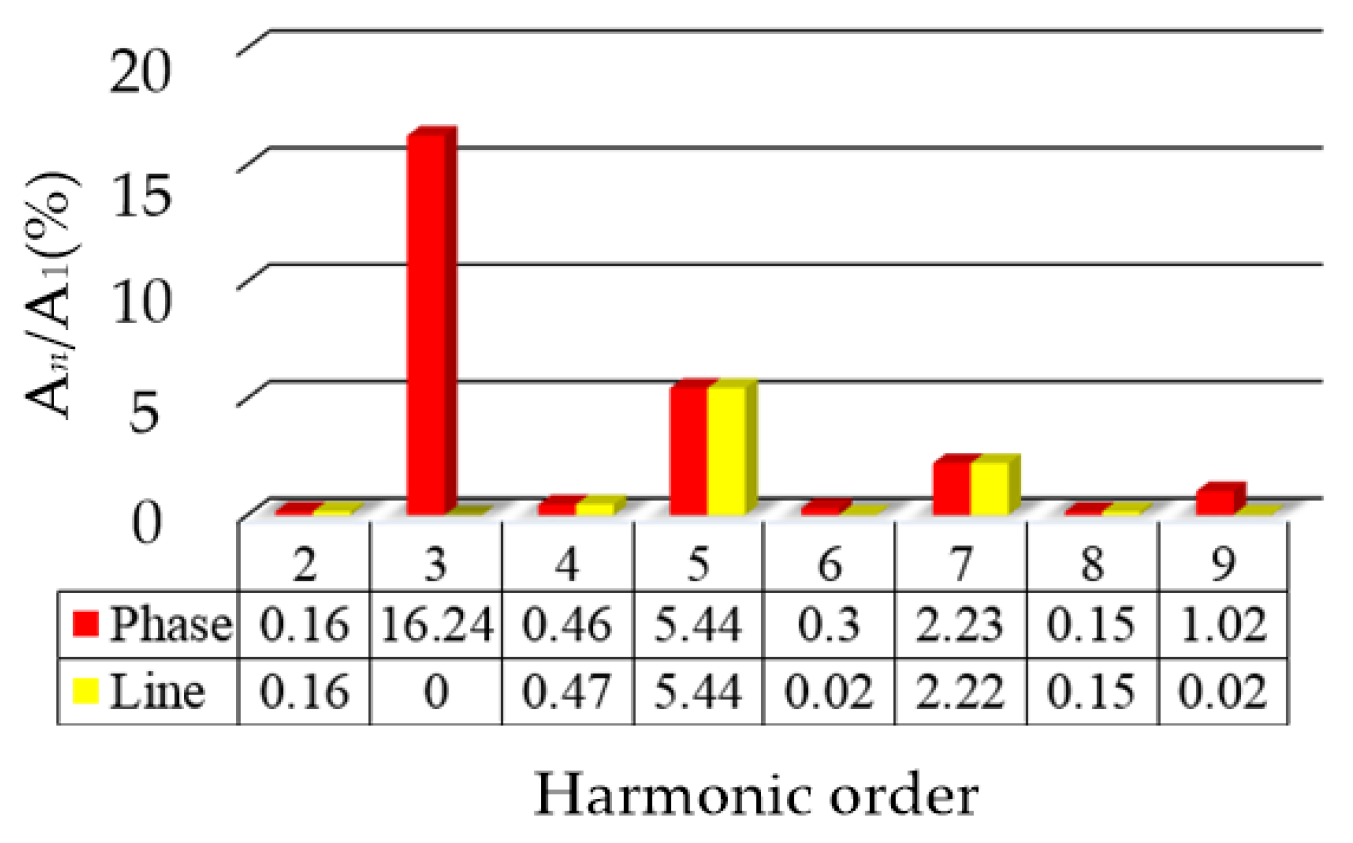


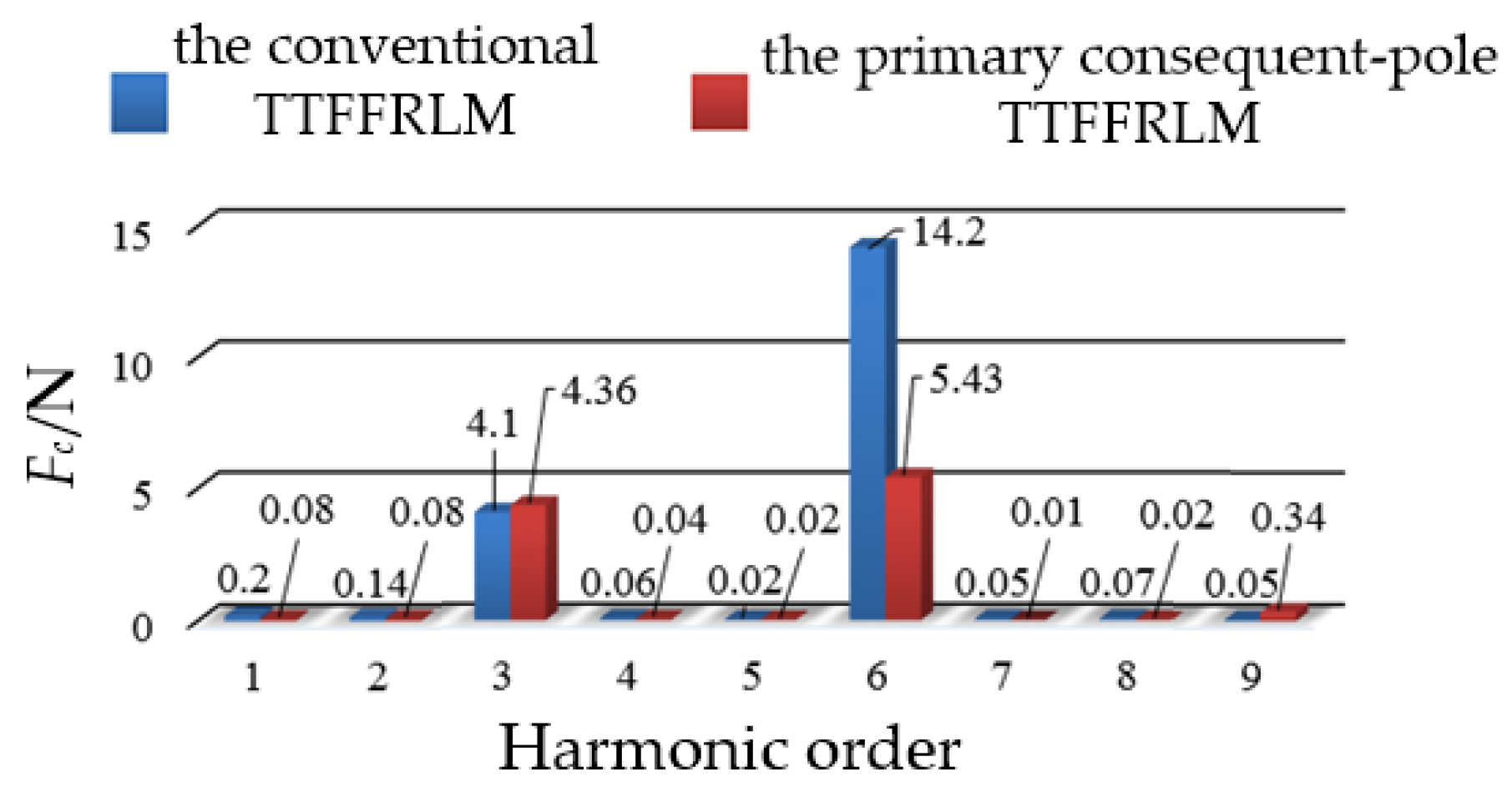

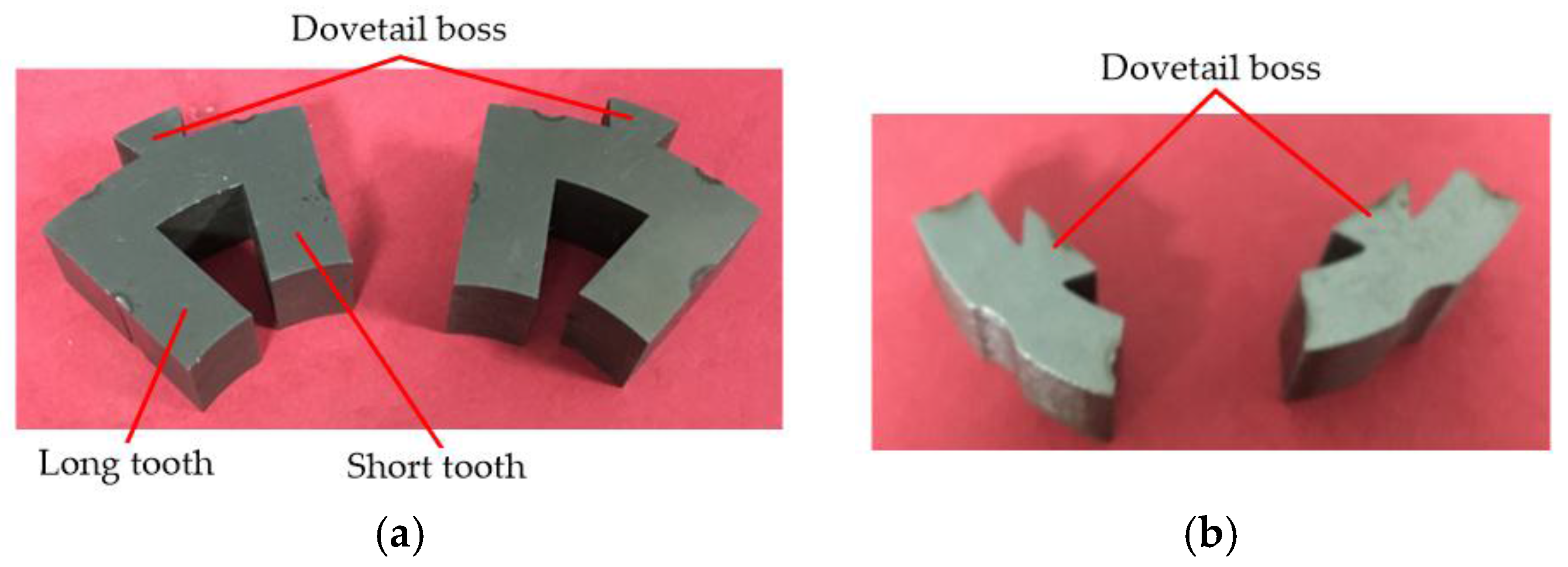
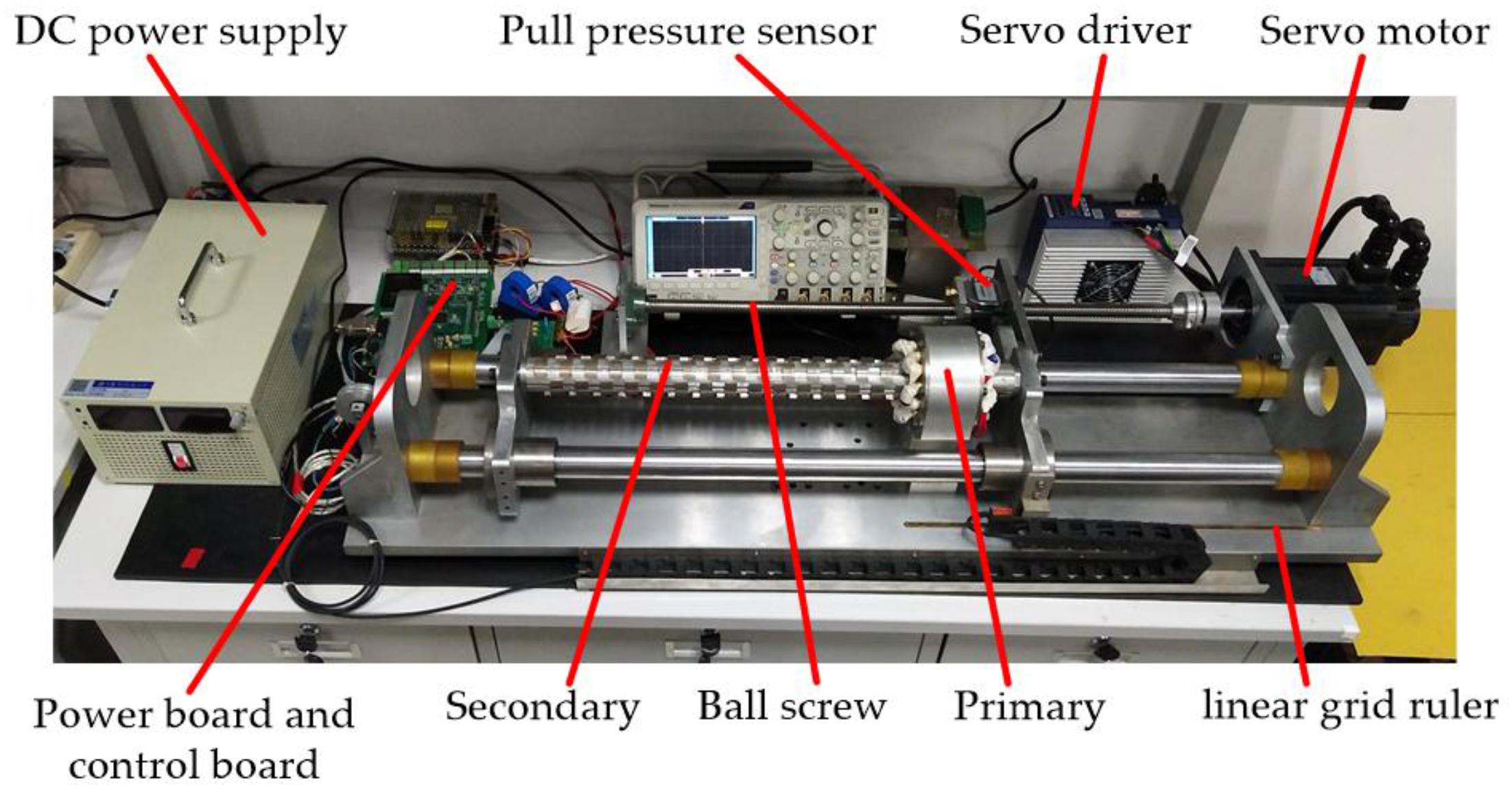

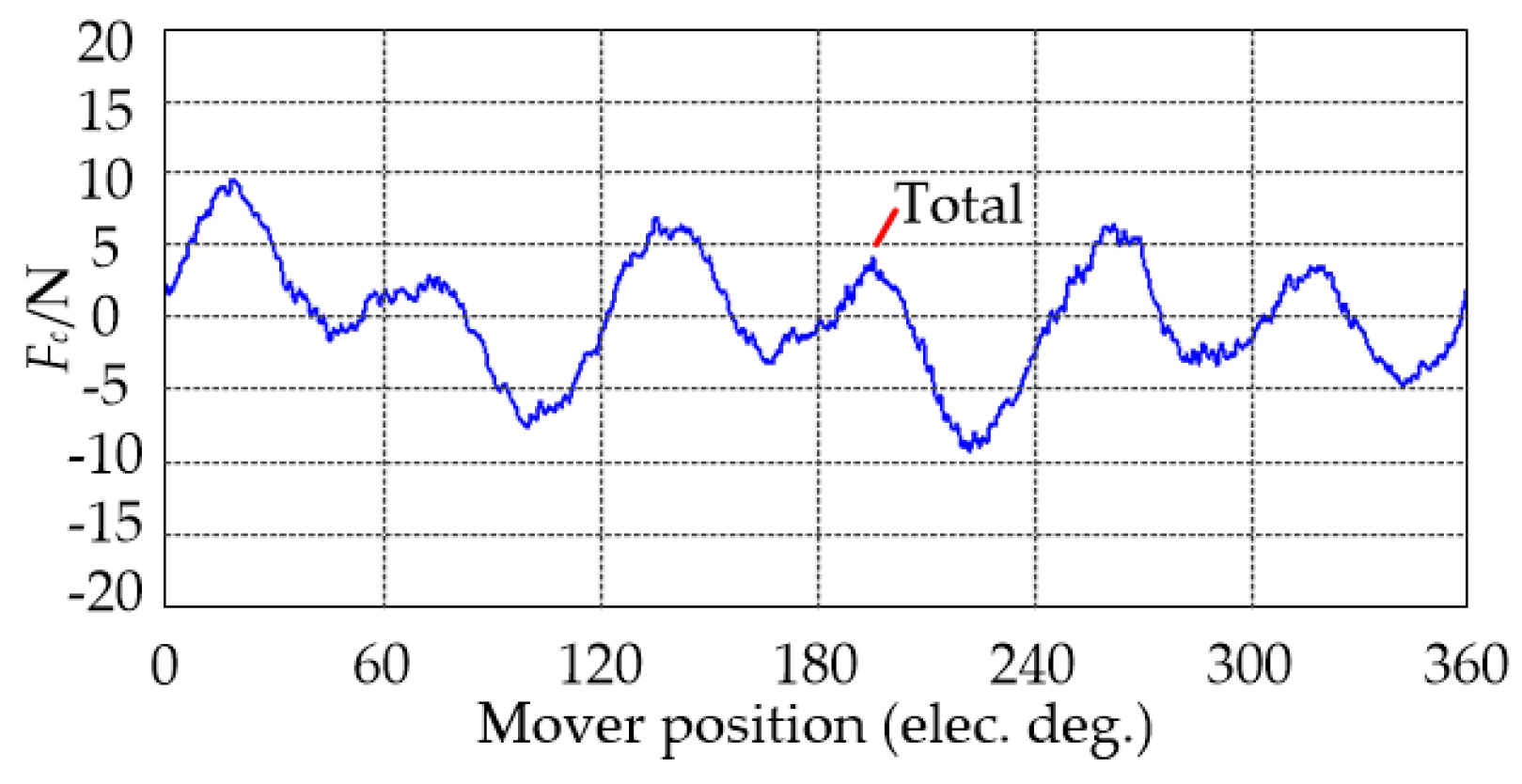
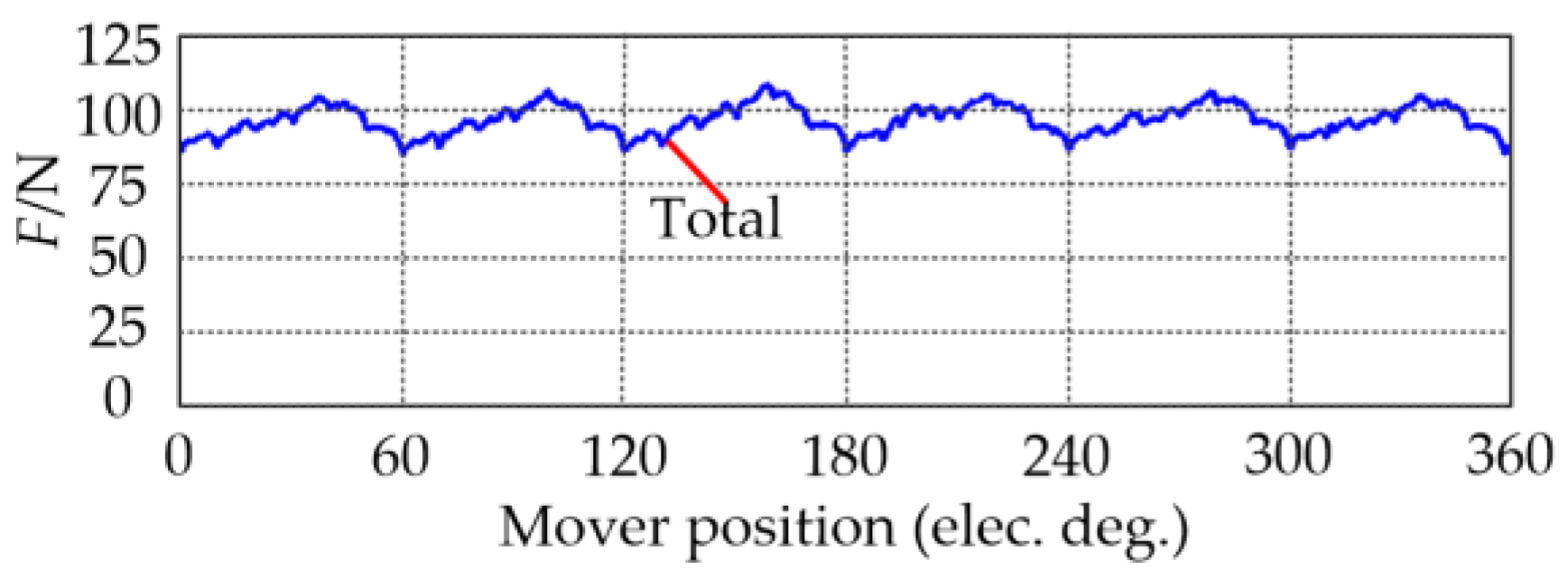
| Parameter(Unit) | Symbol | Value |
|---|---|---|
| Outer diameter (mm) | Do | 100 |
| Internal diameter (mm) | Di | 54 |
| Primary iron core length (mm) | L | 60 |
| Minimum mechanical airgap (mm) | g | 1 |
| Pole-pitch (mm) | τ | 15 |
| PM thickness (mm) | hpm | 3 |
| PM width (mm) | wpm | 10 |
| Primary iron core unit thickness (mm) | hp | 15 |
| The width of the tooth (mm) | ws | 10 |
| The length of the short tooth (mm) | lts | 15.2 |
| The length of the long tooth (mm) | ltl | 18.2 |
| The width of the notch (mm) | wn | 4 |
| The bottom width of the slot (mm) | wb | 13 |
| Secondary iron core unit thickness (mm) | hs | 15 |
| The effective magnetic path length (mm) | hw | 7.5 |
| The model depth of the equivalent 2D FEM (mm) | De | 10 |
| The number of turns of the unit machine armature winding in series | N | 150 |
| PM residual flux density (T) | Br | 1.3 |
| Rated current (A) | - | 7.5 |
© 2017 by the authors. Licensee MDPI, Basel, Switzerland. This article is an open access article distributed under the terms and conditions of the Creative Commons Attribution (CC BY) license (http://creativecommons.org/licenses/by/4.0/).
Share and Cite
Dong, D.; Huang, W.; Bu, F.; Wang, Q.; Jiang, W.; Lin, X. Modeling and Static Analysis of Primary Consequent-Pole Tubular Transverse-Flux Flux-Reversal Linear Machine. Energies 2017, 10, 1479. https://doi.org/10.3390/en10101479
Dong D, Huang W, Bu F, Wang Q, Jiang W, Lin X. Modeling and Static Analysis of Primary Consequent-Pole Tubular Transverse-Flux Flux-Reversal Linear Machine. Energies. 2017; 10(10):1479. https://doi.org/10.3390/en10101479
Chicago/Turabian StyleDong, Dingfeng, Wenxin Huang, Feifei Bu, Qi Wang, Wen Jiang, and Xiaogang Lin. 2017. "Modeling and Static Analysis of Primary Consequent-Pole Tubular Transverse-Flux Flux-Reversal Linear Machine" Energies 10, no. 10: 1479. https://doi.org/10.3390/en10101479




